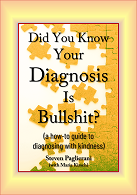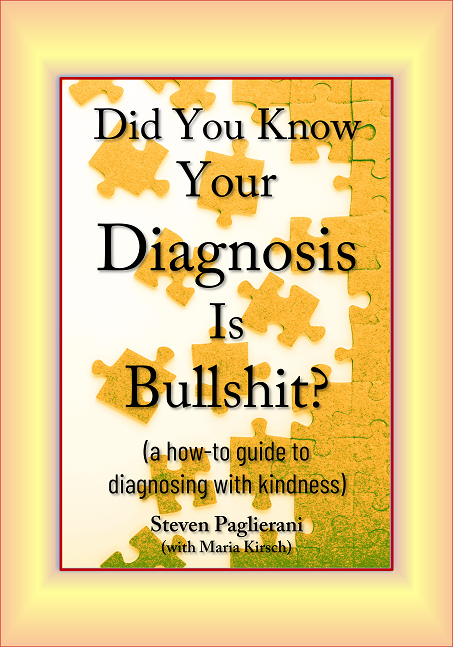
Did You Know Your Diagnosis Is Bullshit (a how-to guide to diagnosing with kindness)
978-1-948911-02-3 $89.95
A Few Words About Diagnosis From a “Still Becoming Human” Author
Based on this book’s title, I imagine, many professionals will pass on it. When I think about them doing this, I feel surprised by my near-total lack of concern. I’ve purposely chosen this title in hopes I’ll pique the interests of people who value being human more than being professional. No coincidence, this includes me and my many colleagues, most of whom have spent whole lives helping people.
Know I count among my colleagues warm-hearted grandmas and new mothers, many of whom function as the family diagnostician. If any of this fits you, then you are definitely in the right place—especially if you’ve wanted to call “bullshit” on the things many so-called professionals claim to know about you and those you love. I know I have.
In truth, if you’ve made it this far, I’m quite sure you’ve felt this way many times. Please (mad author shouting to the heavens), how about some chicken soup for the soul, rather than more chicken shit for the mind. This said, I would not expect you to read much further without me giving you the five-cent tour. What will this book do for you? What’s in it for your patients? This is what I’m about to tell you.
Everyone Diagnoses—Some of Us Do It Professionally
Let’s begin with this book’s main point—that almost everyone alive diagnoses. Sadly, despite the word “manual” in the titles of existing diagnostic manuals, as of today, we have had no manual to guide us. Until now. This book is a no-bullshit book about diagnosis.
PSY042000 PSYCHOLOGY / Assessment, Testing and Measurement
MED018000 MEDICAL / Diagnosis
PSY022000 PSYCHOLOGY / Psychopathology / General
PSY029000 PSYCHOLOGY / Reference
What Is This Book About?
This is my fifth book. The previous four are more textbooks than easy reading. Know this book is largely a practical composite derived from the previous four books. This one does have some textbook shit in it. But it’s also filled with easy-to-read pages. There are also dozens of interesting drawings, the kind young children love.
My hope this time? That I can reach the five or six-year-old child in you. The curious, wide-eyed, aspiring child diagnostician who loves looking at the pictures. The seven-year-old who desperately wants to be taught how to help.
Know I had similar hopes each time I released one of my previous books. I hoped they would make a difference in at least a few people’s lives. What I now know though is that words alone, no matter how eloquently expressed, can never adequately describe the human mind. Rather, the only way to reach the mind, in a lasting way, is with pictures.
The video I've placed above talks about how I came to know this.
This then is the first thing this book will offer you, a way to understand, and teach yourself to speak about, the mind, in fine detail. Not mainly with words, mind you. Rather, with a visual alphabet. This alphabet is comprised entirely of easily recalled drawings of colored, shaped lines.
What are these lines like?
A flat one will teach you to know the state of mind we call “depression.”
A jagged one will teach you what “mania” is like.
A curvy one will show you what a “normal” state of mind looks like.
A less-curvy one will teach you what “dysthymia” (low normal) is.
Then there are two, strangely shaped lines which reveal the nature of getting wounded and healing. How does getting wounded, and healing, change the mind? Imagine being able to teach your patients what these two things are, along with the nature of their diagnosis? Imagine giving this to them in ten minutes or less?
Know that each time you do this, that person will be able to effortlessly retain a sense of who he or she are for the rest of his or her lives. How can any of this be possible? It is. I promise. To do this though you’ll need to learn to harness the visual power of fractal drawings. “Fractal?” You’ll hear this word a lot in this book.
Like ocean waves, and candle flames, and cumulus clouds, fractal shapes are easily learned, recognizable patterns. Children learn these fractal patterns in only minutes. Yet they then effortlessly retain this knowledge for the rest of their lives.
The fractal drawings you’ll be exposed to in this book will do the same for you. What you won’t be required to do in this book is to suffer through endlessly boring technical words. Rather, this book will mainly be a “look at the pictures” book. That’s how I’ll teach you to do all this. To diagnose in such a human way that diagnosing someone can and will change a suffering person’s life.
Imagine that.
Imagine teaching someone what their diagnosis means in a kind caring way.
Imagine doing this with such warmth and clarity that it changes their life, for the rest of their life.
This is what you’ll learn how to do in this book. And yes, it will take work and a good amount of patience. But I believe in you. You can do this.
Chapter 1 - The Invisible Mind
Can We Make What’s In The Mind Visible?
How Many Variables Do You See In This Drawing?
How Many Variables Will You Need To Learn?
What Does Any of This Have To Do With The Depression Line?
What Part Does The Information Variable Play In All This?
A Single Moment Square with Multiple Dots
Contrasting and Comparing The Rectangle and The Square
What’s the Big Deal About the Space in Between Corner Dots?
Introducing the “Three Information Sinks”
How Does A Series of Single Moments Become An Event?
A Blank Event-Line Rectangle1614
The “Normal State of Mind” Event Line
How Does Depression Differ From a Normal State of Mind?
How Does Mania Differ From the Normal State of Mind?
How Does Mania Differ From Depression?
How Does Dysthymia Differ From Depression?
How Does Dysthymia Differ From the Normal State of Mind?
Can You Possibly Have Trouble Telling These Four Lines Apart?
Should You Believe This Stuff Without It Being Peer Reviewed?
What Will We Look At Next?
Chapter 2 - Wounds or Symptoms?
What Should Diagnosticians Be Looking For?
What Will We Talk About In This Chapter?
Change Type One: Getting Overwhelmed
Change Type Two: Getting Wounded
Change Type Three: Reliving a Wound
What’s the Most Painful Change? A Hint. It’s Not Getting Wounded
Change Type Four: Healing a Wound1640
Regression and Transference: the Symptom Making Machine
So Where Do Symptoms Come From?
Where’s My Proof That The Mind Does This?
How Much of What Patients Remember is a Reconstruction?
Are All Wounds, “Context Independent?”
What Does It Mean to Say Wounds Are “Context Independent?”
How Does Healing Alter Regression Transference Loops?
How Do You Diagnostically Discern Clinical Significance?
The First Kind of Meta-Symptoms: Wincing and Flinching
Have You Ever Noticed A Client Wincing?
To Diagnose, You Must Learn to See Winces
The Second Meta-Symptoms: Sudden-Onset Mental Blankness
The Third Kind of Meta-Symptoms: Being Unable to Picture Things
Lastly, a Brief Look At The Word “Disorder”
Books by Steven Paglierani
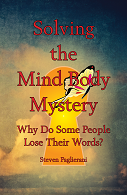
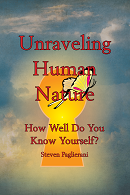
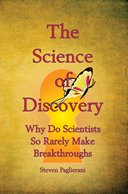
.png)
